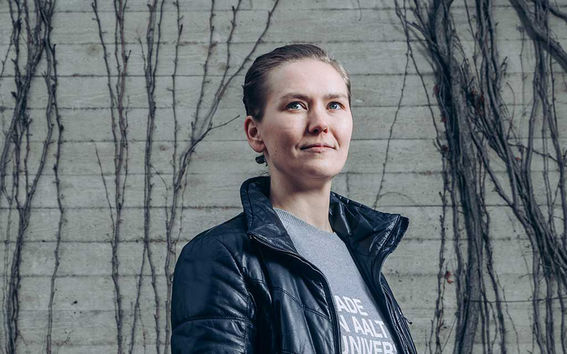Professor Metal

Professor Mari Lundström's field of research is hydrometallurgy and corrosion. When she began her studies at the Helsinki University of Technology in 1998, metallurgists were often seen as cogs of the smokestack industry. However, Lundström believes that the true potential for metal recycling is in the hands of the metallurgical industry and researchers in the field.
– We are the ones who can actually make the circular economy and sustainable development a reality. We possess the technological know-how for it.
Lundström's research group searches for metals in secondary raw materials and develops methods and processes designed to more effectively recover and recycle metals.
Wastes contain precious metals
Secondary raw materials include old mobile phones and computers, car batteries, light bulbs and batteries as well as ash containing metals. These are usually considered waste, because they have already been used, unlike, for example, ore just extracted from the earth.
However, an old mobile phone might contain over 40 different elements and several precious metals, which cannot be recovered using today's processes.
- Your mobile phone contains, for example, copper, tin, silver, gold, zinc, indium and rare earths," explains Lundström.
Lundström's research is motivated by the aspiration to achieve sustainable development. For example, over one-fourth of all lithium production goes to batteries, but the lithium contained in them is not currently recovered to a significant extent.
- We can't keep going like this, with metals being lost in waste and side flows.
Lundström also considers the recycling of metals to be politically significant. She explains that, at present, nearly 90 per cent of the rare earths are produced in China and approximately 70 per cent of lithium in South America.
- The EU should be able to produce metals from secondary raw materials, so that we wouldn't be dependent on other parts of the world.
Marketable product for Finland?
A large part of the work done by Lundström's research group is experimentation and modelling.
– We conduct a lot of, for example, electrochemical experiments, leaching tests, analyses and process modelling, not to mention metallurgical data modelling," lists Lundström.
The work days are long, as Lundström wants to be involved in everything. As we walk down the department hallway together, we are bombarded with a hail of questions coming from the rooms: Mari, could you come take a look at this? Mari, we found something!
Lundström feels that it is rewarding to delve into test results with the students for hours on end. The lack of time is a challenge, but Lundström admits that she bears a lion's share of the responsibility for her work.
– Finland has loads of big companies operating in the metallurgy sector, so, yes, our research group has to be world class, too.
Lundström believes that metallurgists are capable of doing great things: developing more environmentally-friendly processes and improving the status of Finnish industry.
- It would be great to see a method we developed become a commercial application and marketable product for Finland or Europe.
From industry to university
Lundström assumed the mantle of professor in February 2015. Before that, she worked for several years in industry with a company called Outotec. She earned her doctorate in 2009, conducting research and publishing papers as a hobby alongside her job.
In 2013, the School of Chemical Technology opened a call for applications in the Tenure Track career system for an Assistant Professor post.
– It was then that the docent who had been my mentor asked if I had ever considered applying for a professorship. And the seed was planted.
Lundström believes that problem-solving skills are needed when working both in industry and academia. She does not consider herself to be exceptionally intelligent, but believes she is good at finding solutions to a variety of problems.
Understanding phenomena is also important to Lundström.
– When students say that an experiment has gone sideways, I tell them to not think of it that way. I want to understand how that result was reached and what was behind it.
Professors of Aalto University School of Chemical Technology
chem.aalto.fi
- Published:
- Updated:
Read more news

The alumni of Aalto University gathered for the first time at alumni events in Vietnam
A total of over 70 alumni and friends of Aalto gathered in Hanoi and Ho Chi Minh City in November for alumni events hosted by Timo Korkeamäki, Dean of the School of Business.
Unite!’s Open Science and Innovation Management Handbook now available online and in print
The handbook is a practical guide for university researchers, R&I support services, and university managers.